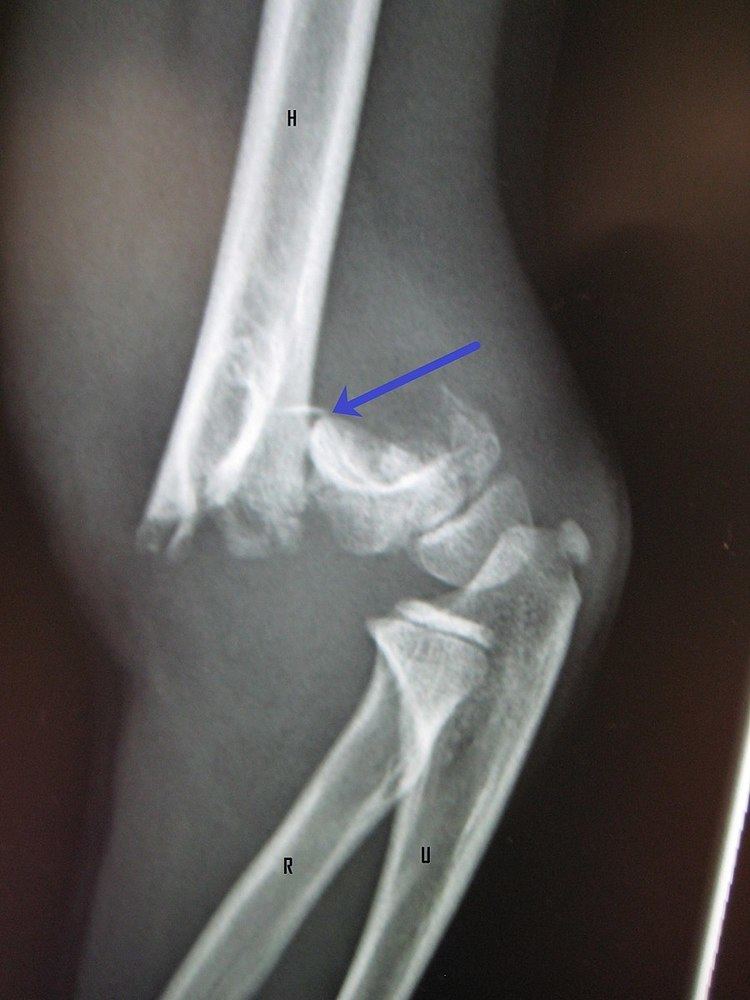ICD-10 S42.4 eMedicine 1269576 | AO 13-A2.3 | |
 | ||
A supracondylar humerus fracture is a fracture of the distal humerus just above the epicondyles. While relatively rare in adults it is one of the more common fractures to occur in children and is often associated with the development of serious complications.
Contents
Signs and symptoms
Neurovascular complications
The Pink and Pulseless hand in supracondylar fracture has been assigned the following causes:
- tear or entrapment of the brachial artery
- spasm of the artery and
- compression of the artery relieved by manipulation of the fracture
- compression of median nerve.
Thus there is loss of circulation of forearm, causing lack of reperfusion of tissues resulting in tissue death causing compartment syndrome. (See Volkmann's contracture)
Therefore, the complications of elbow dislocations include the following:
Other injuries
Mechanism
The fracture is caused by fall on an outstretched hand in 70% of cases. As the hands hits the ground, the elbow is hyperextended resulting in fracture above the condyles. This fracture is most commonly seen in children between the ages of 5-15 yrs. It is a very important clinical condition where medical attention is necessary.
There are two ways supracondylar fractures occur, high impact on a hyperextended elbow or a supracondylar flexion of more than 90 degrees. Fractures of the distal humerus are most commonly due to a falling on your hand with arms fully extended, causing direct trauma to the elbow. The distal condylar complex would shift in either the posterolateral or posteromedial direction, which account for approximately 95% of supracondylar fractures. The remaining 5% of these fractures result from a direct blow to the posterior aspect when the elbow is flexed more than 90°. In these cases, the distal condylar complex is more likely to displace in the anterolateral direction.
Patho-anatomy
The fracture lines extend transversely through the distal end metaphysis above the condyles.
Diagnosis
Diagnosis is usually by x-ray. The fracture can however be difficult to identify and often a joint effusion is used to increase one's suspicion of the presence of a fracture. The existence of an effusion can be determined by the presence of the sail sign.
Upon examination the doctor will evaluate the arm for signs of damage to the nerves and blood vessels; they will look for swelling and deformity. This will allow the doctor to determine a likely diagnosis. Damage to the elbow is a common injury in children; injuries to blood supply of the arm may necessitate early surgical intervention. Most of the supracondylar fractures are minor and require a period of rest, analgesia and compression prior to graduated formal rehabilitation. In the event of a more severe injury, the fracture will be visible on an x-ray. It is important in diagnosis to understand the dynamics of an x-ray because growth plate fractures may not show up like normal broken bones. It is a good idea to compare the x-ray of the injured elbow to the opposing side for analysis. If rest does not cause the fracture to heal then the child must be referred to a specialist for assessment of the injury.
Classification
It may be of a flexion type or an extension type, depending upon the displacement of the distal fragment of bone.
Extension type
The most common type, accounting for 95% of all supracondylar fractures. The distal fragment is displaced posterior.
Flexion type
The least common variety (5%), where the distal fragment is displaced anterior relative to the proximal segment.
Displacements
The displacements may present in one of a number of ways: posterior shift, posterior tilt, lateral or medial shift, proximal shift or internal rotation.
Supracondylar fractures can also be categorized by the Gartland classification system, based upon the degree of displacement of the distal fragment.
According to a website for orthopedic surgeons, “This is the most common elbow fracture in children, about 60% of fractures in children. It is most common in children <10, peak incidence is between the ages of 5-8 years of age. Primarily in children who are around age 7 years, which is often a period of maximum ligamentous laxity; therefore, the elbow hyperextends when the child tries to catch himself or herself during a fall. During the hyperextension process, the olecranon (elbow bone) process is forced against the weaker, immature metaphyseal bone of the distal humerus, producing the typical extension-type supracondylar fracture”.
Treatment
"Most orthopedic surgeons (96%) agreed that the treatment of choice for displaced supracondylar fractures of the humerus in children is closed reduction and percutaneous pinning"
Surgery may lead to improved outcome of displaced fractures. The degree of reduction can be measured by Baumann's angle.
